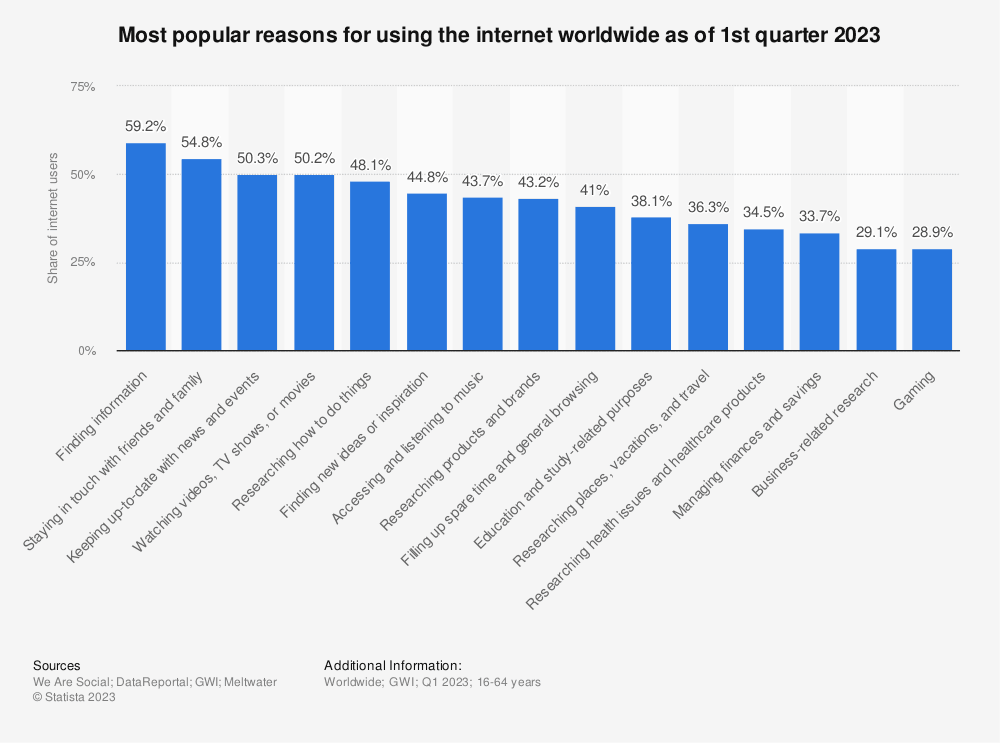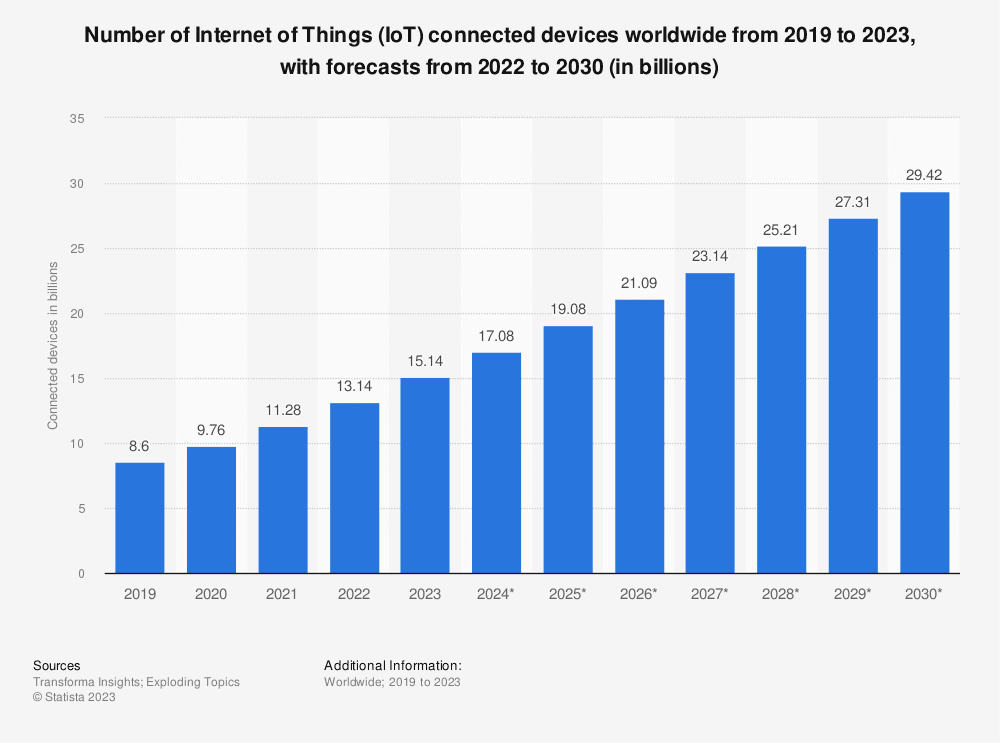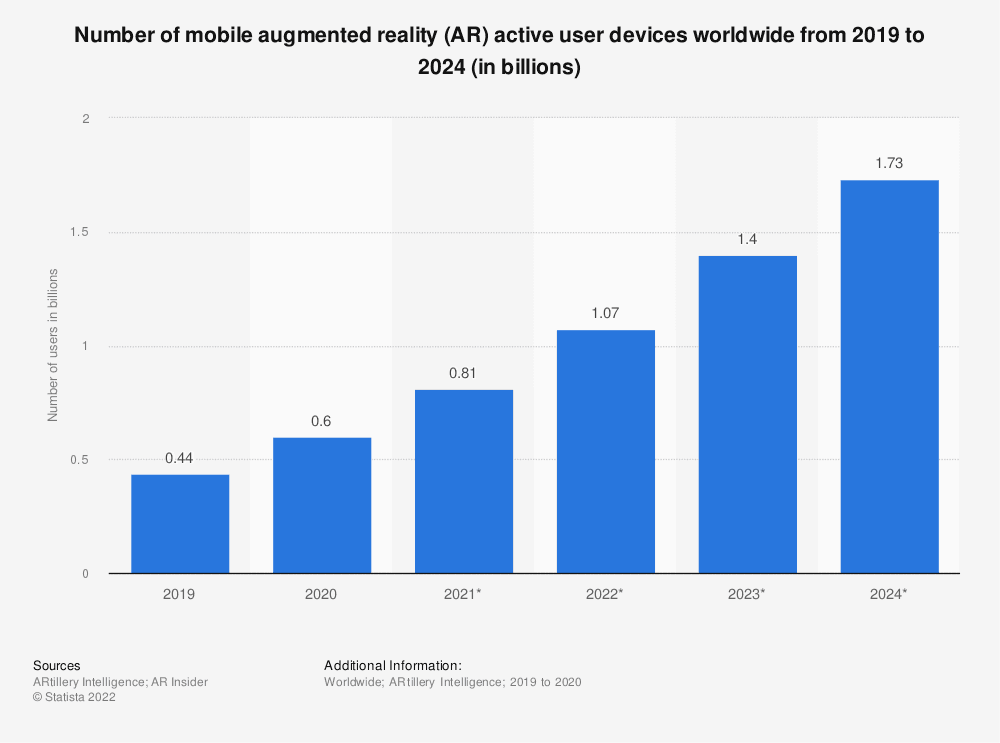In the ever-evolving technology landscape, the field of web development is a dynamic and vital component of our digital landscape. That's why web developers strive to create immersive and effective online experiences for users around the world every year. In this article, we will delve into the world of web development, uncovering the latest web development technologies and trends that are set to redefine the digital landscape in the coming years. So, what is the future of web development?
The statistics paint a compelling picture of the web development industry's significance. As of Internetlivestats data in 2023 there are:
- more than 5.038 billion internet users in the world;
- about 1.8 billion websites;
- 4.48 billion active social media users;
- 3.5 billion Google searches each day, 1.2 trillion searches each year;
- more than 380 new websites are created every minute.

However, as the digital world expands, so do the challenges faced by web developers. The need for faster load times, responsive design, and heightened security has intensified.
What Drove Changes in Web Development Over the Last 5 Years?
In the past five years, web development has undergone significant changes due to a combination of technological advancements and shifting user needs. Let's explore the driving forces behind these changes and the key technologies that have played crucial roles:
1. Mobile-First and Responsive Design:
The proliferation of smartphones and mobile devices has fundamentally altered user behavior. Web development shifted toward mobile-first and responsive design strategies to ensure seamless experiences across various screen sizes and resolutions.
2. Progressive Web Apps (PWAs):
Among the new trends in web development, PWAs have gained significant popularity at one time, blurring the line between websites and native mobile applications. They offer offline functionality, push notifications, and fast loading times, enhancing user engagement.
3. Single Page Applications (SPAs):
SPAs, powered by frameworks like React, Angular, and Vue.js, have become increasingly popular due to their ability to provide smooth, app-like experiences within a web browser.
4. Blockchain and Cryptocurrencies:
The rise of blockchain technology, led by cryptocurrencies like Bitcoin and Ethereum, has profoundly impacted web development. Blockchain's transparency and security features paved the way for various innovations, including:
a. Smart Contracts:
These self-executing contracts, powered by blockchain, automate and enforce contract terms, reducing the need for intermediaries.
b. Decentralized Applications (dApps):
dApps run on decentralized networks like Ethereum, enabling trustless and censorship-resistant applications, which has disrupted industries like finance, gaming, and more.
5. Serverless Architecture:
Serverless computing, exemplified by AWS and Azure, simplifies web development by abstracting server management. Developers can focus on code, while cloud providers handle scalability and infrastructure.
6. Artificial Intelligence and Machine Learning:
AI and ML libraries and tools like TensorFlow.js and PyTorch have made their way into web development, enabling applications to offer personalized experiences and automate tasks.
13 Web Development Trends That Have Impressed Us in 2023
As 2024 approaches, the world of web development continues to evolve rapidly, introducing exciting trends and innovations that have impressed us.
IoT
Why has IoT emerged as one of the most influential latest web development trends? The key lies in the continuous flow of data generated by IoT-connected devices. This constant data transfer allows companies to swiftly engage with users and deliver personalized experiences.
One of the most well-known examples of an IoT device is Google Nest smart speakers. These smart IoT devices enable users to access features like media playback, alarms, lighting control, and more through voice commands alone.
IoT fosters advanced communication between website layouts and operational models. Websites are increasingly integrating sensors, cameras, and signaling equipment, enhancing their ability to efficiently address user requests and provide highly relevant responses.
Here's how people benefit from IoT:
Health and Wellbeing:
Wearable IoT devices, such as fitness trackers and smartwatches, help individuals monitor their health and fitness levels. These devices can track steps, heart rate, sleep patterns, and more, empowering users to make healthier lifestyle choices.
Energy Conservation:
IoT-enabled smart home devices, like energy-efficient lighting and thermostats, help homeowners reduce energy consumption.
Safety and Security:
Video surveillance, doorbell cameras, and motion sensors enhance safety by deterring intruders and allowing users to monitor their property remotely.
Healthcare Advancements:
IoT applications in healthcare include remote patient monitoring, smart medical devices, and telemedicine. These innovations enable healthcare providers to offer more personalized care and patients to receive medical attention.
Transportation and Smart Cities:
Smart traffic management systems reduce congestion and improve traffic flow, while IoT-enabled public transit systems enhance the commuter experience.
Agriculture and Precision Farming:
IoT sensors and drones are used in agriculture for precision farming, enabling farmers to monitor soil conditions, crop health, and weather patterns.
You can explore the case study of one of our projects using IoT. Plair is an application designed to receive, manage, and analyze real-time air pollution data from smart bioaerosol sensors in any environmental condition.
If you need evidence of IoT's rapid ascent as a technology in web development, consider the data from Statista.

AI-Powered Chatbots
These chatbots are equipped with artificial intelligence (AI) and natural language processing (NLP) capabilities, enabling them to engage in human-like conversations with users. They have found widespread applications in various industries, and people benefit from them in numerous ways:
Enhanced Customer Support:
AI-powered chatbots provide 24/7 customer support, allowing businesses to respond to customer inquiries and issues at any time.
Multilingual Support:
AI chatbots can communicate in multiple languages, making them valuable for businesses with a global customer base.
Data Collection and Analysis:
Chatbots collect valuable user data during interactions. This data can be used to gain insights into customer behavior, preferences, and pain points, helping businesses make informed decisions.
24/7 E-commerce Assistance:
In the e-commerce sector, chatbots assist customers with product recommendations, order tracking, and resolving issues, leading to increased sales and improved customer loyalty.
Healthcare Support:
Chatbots in healthcare help users find information about symptoms, schedule appointments, and receive medication reminders, improving healthcare accessibility and patient engagement.
Educational Assistance:
Technology can be integrated into educational platforms to answer student queries, provide tutoring, and offer learning resources, enhancing the educational experience.
Virtual Assistants:
AI chatbots can serve as virtual assistants, helping users with tasks like setting reminders, checking the weather, and booking appointments, streamlining daily routines.
Emergency Response:
Chatbots can offer immediate assistance during emergencies, providing critical information, guidance, and support to users in distress.
The most popular representatives of this category are СhatGPT, Google Bard, Bing Chat, PerplexityAI, JasperAI, YouChat, etc.

Mobile-First Approach
This strategy prioritizes designing and optimizing websites and web applications for mobile devices before addressing their desktop counterparts. The trend has gained significant importance as mobile usage continues to surge globally:
Improved User Experience:
Mobile-first design ensures that the website or app is tailored for the smaller screens and touch interfaces of mobile devices. This leads to a more intuitive and user-friendly experience for mobile users.
Faster Loading Times:
Mobile-first designs tend to be lightweight, with optimized images and code.
Better SEO:
Search engines like Google prioritize mobile-friendly websites in their search rankings.
Cost Savings:
Starting with a mobile-first approach can save development time and costs. It simplifies the design process by focusing on essential features and functionalities first.
Reduced Maintenance Complexity:
Developers can focus on core features and progressively enhance them for larger screens, reducing maintenance complexity.
Better Conversion Rates:
Mobile-optimized websites and apps often lead to higher conversion rates for e-commerce, sign-ups, and other user interactions, as users find it easier to complete desired actions on mobile.
PWAs
These web applications leverage web technologies to offer users a seamless, fast, and reliable experience, whether they're using a desktop browser or a mobile device.
Cross-Platform Compatibility:
PWAs work on multiple platforms, including desktops, smartphones, and tablets, eliminating the need to develop and maintain separate native apps for each platform.
Offline Access:
These apps can work offline or in low-network conditions, thanks to service workers that cache content.
App-Like Experience:
PWAs offer an app-like experience with smooth animations, transitions, and interactions, making users feel like they are using a native mobile app.
Faster Load Times:
They are designed for quick loading, reducing bounce rates, and improving user engagement.
Automatic Updates:
PWAs update in the background, ensuring that users always have access to the latest features and security patches without the need for manual updates.
Improved SEO:
Apps are discoverable by search engines, making it easier for users to find and access your content through search results.
Push Notifications:
PWAs can send push notifications to users, similar to native mobile apps, enabling businesses to re-engage users with personalized updates and promotions.
Device Integration:
PWAs can access device features like cameras, GPS, and sensors, enabling location-based services and advanced functionalities.
User-Friendly Installation:
Users can add PWAs to their home screens with a single tap or click, creating a shortcut for easy access, just like installing a native app.
Among the well-known applications of this type are Facebook, Pinterest, Twitter, Uber, The Washington Post, etc.
Serverless Architecture
Serverless Architecture is a cloud computing approach that allows developers to build and run applications without the need to manage traditional server infrastructure. Despite the name, servers are still involved, but the management of these servers is handled by the cloud provider. The primary benefits of this approach can be summarized as follows:
Enhanced Scalability:
Serverless architectures effortlessly adapt to fluctuations in demand. They automatically scale resources up or down as needed, ensuring optimal performance during traffic spikes and saving costs during quieter periods.
Faster Time-to-Market:
The approach allows teams to focus primarily on coding, reducing the time required for infrastructure management. This streamlined process accelerates product development and deployment.
Cost-Effectiveness:
Serverless computing eliminates the need for maintaining and provisioning servers, reducing infrastructure overhead. You only pay for the computing resources used, resulting in cost savings and efficiency gains.
Delegated Maintenance:
Serverless platforms take on the responsibility of infrastructure maintenance, including updates, security patches, and server management.
The largest cloud service providers are AWS, Azure, and Google.
In our portfolio, you can see applications that are distributed using the SaaS model and are available to users thanks to cloud services:
SMARTSUITE: WORK MANAGEMENT PLATFORM
SHOOTQ: PHOTOGRAPHY MANAGEMENT CRM SOFTWARE
LOOQME: MEDIA MONITORING SYSTEM
WebAssembly
It is a binary instruction format designed for secure and efficient execution on web browsers. WebAssembly (Wasm) allows developers to run high-performance, low-level code in a web browser, opening up new possibilities for web applications. This in turn provides the following advantages:
Near-Native Performance:
WebAssembly allows developers to execute code at near-native speed in web browsers. This means that compute-intensive tasks can be handled efficiently, providing a smoother user experience.
Cross-Platform Compatibility:
This ensures that applications built with WebAssembly can run on a wide range of devices and platforms without modification.
Language Agnosticism:
WebAssembly is language-agnostic, meaning developers can write code in languages like C, C++, Rust, and even languages like Python, and compile it to run in web browsers.
Code Reusability:
Wasm enables code reuse between web and non-web environments. Developers can reuse existing codebases, libraries, and components, saving time and effort in development.
Enhanced Security:
WebAssembly runs in a sandboxed environment, isolating it from the rest of the web page. This ensures that potentially unsafe code does not have direct access to a user's system or sensitive data.
Web-Based Games:
Wasm has opened the door for high-quality, browser-based games that rival the performance of native games.
Real-Time Applications:
WebAssembly is used in real-time applications, such as video and audio editing tools, as it can handle complex computations and deliver responsive user interfaces.
What to Expect in 2024?
Now let's take a closer look at what trends will gain momentum next year and shape web development future. The appearance of some of them a few years ago seemed like the plot of a science fiction film, but they are increasingly becoming a part of our reality.
More Meta-Frameworks
In recent years, developers have been creating single-page SPA (Single Page Application) applications using frameworks like React.js, Vue.js, and Svelte.js. However, there's a noticeable shift in the programming landscape towards server-side rendering (SSR) when working with these JavaScript frameworks.
What frameworks can be considered popular in 2024?
- Gatsby.js is an open-source framework based on React. Used to create fast applications and websites that are easy to navigate;
- Vue.js is a framework that is great for creating interesting and creative interfaces;
- Svelte.js is a recently debuted framework that has confidently won an army of fans. It is based on three concepts: less code, no virtual DOM, and true reactivity.
Blockchain-as-a-Service (BaaS)
Among other recent trends in web development, we see blockchain technology quickly gaining traction in enterprise transactions in 2023. Companies are increasingly relying on the decentralization of blockchain, using this technology in their operations and receiving increased security and protection from cyber-attacks.
This, in turn, will be reflected in the growing popularity of blockchain as a service in 2024. The benefit for business is obvious - companies will be able to develop and maintain their blockchain applications without spending resources on maintaining the blockchain infrastructure.
The obviousness of the trend is confirmed by statistics. According to a new report from Grand View Research, the global blockchain technology market size will reach US$1,431.54 billion by 2030, growing at a CAGR of 87.7% from 2023 to 2030.
Blockchain experts predict that individual industries will increase the influence of technology in their processes. These industries include Supply Chain, Pharmaceuticals, Food and Beverage, Telecommunications, and, of course, Financial Services.
When applied to supplies, blockchain significantly reduces double-counting errors.
In the pharmaceutical market, blockchain helps to successfully combat the penetration of counterfeit or unlicensed medicines.
In the food industry, QR-based "digital signals" generated by scanners, mobile phones or other applications create digital records for food and beverage products that contain specific information such as codes, lot numbers, or tray and box locations.
In the telecommunications industry, blockchain is great for managing mobile roaming traffic.
Extended Reality (XR)
XR is an extended term that combines virtual reality (VR), augmented reality (AR), and mixed reality (MR). Today, XR technologies are actively used and open up many new opportunities for businesses to interact with customers, and according to Precedence Research, the global extended reality market will reach a whopping $345.9 billion by 2030.
What are the significant business benefits and impact on the future of web design and development?
Data access and qualitative analysis:
Eye tracking, emotion monitoring, behavior analysis, biofeedback, biometrics, and spatial analytics - these mechanisms collect and prepare data for further analysis and decision-making.
Unique user engagement:
Personalized virtual shopping, virtual reality gamification, try-on experiences, virtual introduction of new products and services, AR-based assistance. An almost amazing way to promote products and services. For example, IKEA is now using XR technology to improve the shopping experience for its customers. The company provides a virtual showroom where buyers can explore more than 50 furnished or empty spaces.
Unconventional and enhanced collaboration:
XR technologies allow businesses to improve processes and interactions within teams by playing out and simulating various operational scenarios, holding VR conferences, etc.

According to Statista, extended reality will be most widespread in Healthcare, Marketing and Education. For example, in Healthcare it ranges from holograms of the human body and organs for student practice, surgical simulations for training surgeons, and ending with surgical robots. For example, Stanford Medicine uses augmented reality software to combine images from MRIs, CT scans, and angiograms to create a 3D model that doctors and patients can study and manipulate.
Software for Drones and Robots
The robotics field will increasingly intersect with almost all industries.
Startups and large companies are developing autonomous mobile robots to move materials seamlessly. AGVs (Automated guided vehicles) also transport finished products from assembly lines to warehouses. Cobots (collaborative robots) are making their way onto manufacturing floors to improve production productivity.
Additionally, the robotics industry is leveraging technologies such as artificial intelligence (AI), the Internet of Things, and cloud computing to improve the performance of robots. At the same time, growing concerns about cyberattacks require the development of robotic cybersecurity solutions. Finally, assistive robots minimize the physical dependence of humans, and Robotics as a Service (RaaS) allows businesses to quickly integrate robotics.
Advances in high-performance computing and new web development technologies are allowing startups to create drones with increased capabilities. They find applications in a wide range of industries: package delivery, aerial image collection, infrastructure inspection, and much more. For example, agricultural drones monitor crops and control the movement of livestock, as well as deliver pesticides and sow seeds. The flexible capabilities of drones further accelerate their integration into last-mile food and medicine delivery, among others.
Smart Cities
Smart cities are no longer just a concept, but an increasingly realized trend around the world. Thanks to the development of IoT, municipal authorities are improving infrastructure, services, and quality of life for citizens.
Citizens interact with smart city ecosystems in a variety of ways, using smartphones and mobile devices, as well as connected cars and homes. For example:
- Connected traffic lights receive data from sensors and vehicles, adjusting the frequency and timing of the traffic lights. In this way, they respond to traffic in real time and reduce traffic congestion.
- Connected cars can communicate with parking meters. And also contact charging stations for electric vehicles and show the way to the nearest available space.
- Smart trash cans can send data to waste management companies and schedule waste collection as needed.
- Citizens have a driver's license and digital ID on their smartphones to access government services quickly and easily.
And here are some examples of what has been implemented within the framework of smart cities and will gain momentum next year:
- Given Singapore's aging population, the government is focusing on digital health. They often conduct video consultations with medical professionals and also wear IoT devices to monitor patients. In addition, authorities collect a wealth of additional information using sensors throughout the city, such as the cleanliness of certain areas and the crowds of people at certain events.
- Oslo has more than 650,000 LED lights that intelligently control the amount of energy depending on conditions. In addition, local authorities promise to make all vehicles electric by 2025 and already monitor traffic flow and manage congestion using license plate detectors.
- Copenhagen has implemented a system that monitors air quality, energy consumption, traffic, and waste disposal. The system also connects parking systems, traffic lights, buildings, smart metering, and electric vehicle charging systems to manage traffic flow in real time.

Next-Gen Antivirus (NGAV)
Next-Generation Antivirus (NGAV) solutions are capable of combating the latest cybersecurity threat scenarios. NGAV uses machine learning and behavioral analysis in other attacks that are not detected by legacy antivirus.
NGAV uses the following functions:
- Cloud-native architecture minimizes impact on endpoints.
- Sophisticated techniques and tools to block malware and attacks. For example, machine learning, behavioral analysis, exploit and adware blocking, and customizable lists of allowed and prohibited attacks.
- Signature-free technology to identify and block known and unknown threats, regardless of malware signature updates.
- Online and offline prevention.
- Solutions can be deployed immediately and fully operational within hours.
- Easiest integration into different environments without complicating management.
Analysts predict that by 2025, the total damage from cyberattacks will reach $15 trillion. So NGAV will only develop and completely replace legacy antiviruses.
DNA Digital Data Storage
Professor of synthetic biology at Eindhoven University of Technology Tom De Greef said that in three years there will be no data centers in the world capable of storing even half of all user-generated data. It's hard to believe now, isn't it? But scientists not only declare the problem but also develop solutions. The solution, they say, would be for tech companies to start using synthetic DNA instead of hard drives to store their data.
However, so far scientists have not been able to make DNA storage an effective, affordable, and scalable solution. There are several reasons for this. Firstly, DNA coding and further information extraction require high-tech resources, which are very, very expensive. The cost of chemical DNA synthesis is $3,500 per 1 megabyte of information. Secondly, the process of reading data from DNA can lead to errors and damage the DNA strand.
Scientists continue to look for solutions and believe that DNA will become the main storage method. For example, they are now developing new enzyme-based approaches that make it possible to write DNA easier and faster than traditional chemical methods.
Let's wait to see what happens in a few years.
Consider Gearheart Your Trusted Partner
Our web development services have proven their effectiveness over 10 years of our work. During this time, we created more than 70 products, most of which started as MVPs, and a third of them grew into large long-term projects lasting several years each.
All our developers have deep technical knowledge and vast experience working with various technologies. At the same time, we continue to constantly learn to offer our clients the best solutions in accordance with the latest trends in web application development. In our portfolio, you will find products for various business areas using AI, cloud computing, and the IoT.
If you have a product vision, you just need to contact us and share your idea. There is no need to include technical specifications or other complex documents. We will set up a kick-off meeting with our CEO, give a company presentation, and ask you all the questions to prepare the documentation for you.
Final Thoughts
It is obvious that simply chasing the latest trends in web development does not always benefit a business. However, it is important to keep your finger on the pulse and understand the tendencies that have already been adopted and introduced into the digital landscape. We have collected technologies that increase power year after year and firmly surround us in everyday life. Therefore, we advise you to take a closer look at the listed approaches and web development future trends. Some of them may take your business to the next level. And to discuss which approach or technology is better to take as a basis, you can easily contact us.
Subscribe for the news and updates
FAQ
How will AI/ML integration impact user personalization and recommendations?
Will PWAs ever replace native apps?
How can web developers use 5G technology?






